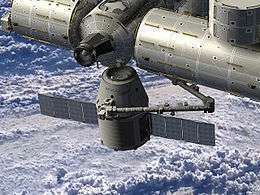SpaceX CRS-11
 Artist rendering of the SpaceX Dragon spacecraft being berthed to ISS | |||||
| Mission type | ISS resupply | ||||
|---|---|---|---|---|---|
| Operator | SpaceX | ||||
| Spacecraft properties | |||||
| Spacecraft | Dragon C13 | ||||
| Spacecraft type | Dragon CRS | ||||
| Manufacturer | SpaceX | ||||
| Dry mass | 4,200 kg (9,300 lb) | ||||
| Dimensions |
Height: 6.1 m (20 ft) Diameter: 3.7 m (12 ft) | ||||
| Start of mission | |||||
| Launch date | Planned: March 2017[1] | ||||
| Rocket | Falcon 9 | ||||
| Launch site | Cape Canaveral SLC-40 | ||||
| Contractor | SpaceX | ||||
| Orbital parameters | |||||
| Reference system | Geocentric | ||||
| Regime | Low Earth | ||||
| Inclination | 51.6 degrees | ||||
| Epoch | Planned | ||||
| Berthing at ISS | |||||
| Berthing port | Harmony nadir or Unity nadir | ||||
| RMS capture | Planned: March 2017 | ||||
| Berthing date | Planned: March 2017 | ||||
| Cargo | |||||
| Pressurised | 1,737 kg (3,829 lb) | ||||
| Unpressurised | 1,573 kg (3,468 lb) | ||||
| |||||
SpaceX CRS-11, also known as SpX-11, is a cargo resupply mission to the International Space Station currently scheduled to be launched in March 2017.[1] The mission was contracted by NASA and is flown by SpaceX. The mission will utilize a Falcon 9 launch rocket and a Dragon v1 cargo vessel.
Launch schedule history
CRS-11 is the second to last of the original order of twelve missions awarded to SpaceX under the CRS contract.[2] As of June 2016, a NASA Inspector General report had this mission manifested for February 2017.[3]
Rocket and spacecraft
This will be the first time that a Dragon spacecraft will be reused and should allow SpaceX to scale back its production line and shift focus to Dragon 2.[4]
Primary payload
NASA has contracted for the CRS-11 mission from SpaceX and therefore determines the primary payload, date/time of launch, and orbital parameters for the Dragon space capsule. According to a NASA Inspector General report of June 2016, CRS-11 is expected to carry 1,737 kg (3,829 lb) of pressurized mass and 1,573 kg (3,468 lb) of unpressurized.[3] According to 2016 presentations, the external payloads manifested for this flight are Nicer, MUSES and ROSA.[5][6]
See also
- List of unmanned spaceflights to the International Space Station
- International Space Station – The space station that this mission will resupply.
- Commercial Resupply Services – The NASA commercial resupply program for the ISS under which this mission was contracted.
- Dragon - The spacecraft that performs this mission.
- Falcon 9 - The rocket that launches the Dragon capsule.
- SpaceX - The Dragon and Falcon 9 designer, manufacturer and operator.
References
- 1 2 "Spaceflight 101 Launch Calendar". Spaceflight 101. 30 October 2016. Retrieved 1 November 2016.
- ↑ de Selding, Peter B. (24 February 2016). "SpaceX wins 5 new space station cargo missions in NASA contract estimated at $700 million". Space News. Retrieved 24 February 2016.
- 1 2 NASA Office of Inspector General (June 28, 2016). NASA’s Response to SpaceX’s June 2015 Launch Failure: Impacts on Commercial Resupply of the International Space Station (PDF) (Report). NASA Office of Inspector General. p. 13. Retrieved 2016-07-18.
- ↑ Jeff Foust (14 October 2016). "SpaceX to reuse Dragon capsules on cargo missions". Space News.
- ↑ Kenol, Jules; Love, John (May 17, 2016). Research Capability of ISS for a Wide Spectrum of Science Disciplines, Including Materials Science (PDF). Materials in the Space Environment Workshop, Italian Space Agency, Rome.
- ↑ Scimemi, Sam (July 2016). International Space Station Status July 2016 (PDF) (Technical report). NASA. Retrieved 2016-07-29.
